Recent Storm Damage Posts
How to Deal With Frozen Pipes in Winter Weather | SERVPRO of St. Charles
1/31/2024 (Permalink)
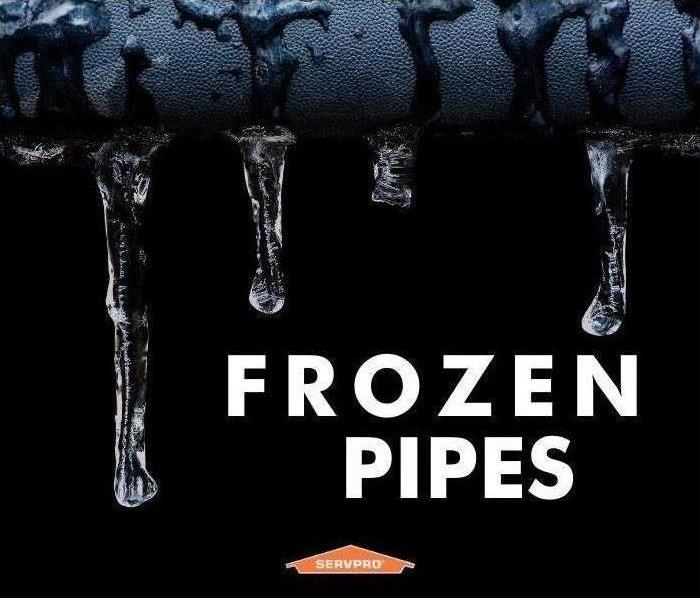 Frozen pipes? Call SERVPRO of St. Charles
Frozen pipes? Call SERVPRO of St. Charles
At SERVPRO of St. Charles City, St. Peters, Dardenne Prairie/Weldon Springs, we often see an increase in water losses during the winter. A major culprit of these losses are frozen pipes. When the water inside the pipes freeze, its molecules expand, which causes a blockage of ice that prevents unfrozen water from passing through. When the frozen pipe begins to thaw, the pressure from the water can cause the pipe to burst. How Can I Tell My Pipes Are Frozen? One of the most common signs that you are dealing with frozen pipes is when you turn on your faucet and no water comes out (similarly, if you flush your toilet and it doesn’t refill). If this happens, you should check your water source to make sure it’s still turned on and that a leak isn’t occurring. Another tell-tale sign of frozen pipes is when your water line is coated in frost or is bulging.If you know that your pipes are frozen, you can either choose to address the issue yourself or call in professionals. How to Prevent Frozen PipesFrozen pipes cause an estimated $400-$500 million in damage annually. To avoid adding to that total, there are several steps you can take.When the weather gets cold, you should drain water from pipes that are likely to freeze, such as sprinkler and swimming pool water supply lines. Outside hoses should also be disconnected and drained, and indoor valves supplying these access points must be closed.On frigid days, let your faucets drip cold water. Having the water drip out will make it harder for the water in the pipes to freeze. Your thermostat should also be kept around the same temperature at all times, and your house temperature should never fall below 55 degrees. Garage doors should also be kept shut to protect water lines. If you are worried about your pipes freezing, you can also place a 60-watt bulb in the areas you’re concerned with. Just make sure none of the materials near the bulb are combustible. What If My Pipes Are Already Frozen? If you realize your pipes have frozen, the first step is to keep your faucet open. This will help with thawing and allow for moving water to flow through the pipe. You can also apply heat to the specific area of the pipe that is frozen. You can do this by wrapping an electronic heating pad around the pipe or heating the area with a hair dryer. Using towels soaked in hot water can help, too. Keep applying heat until water flow returns to normal. After the pipe has been thawed, turn on other faucets around the house to make sure you don’t have any more frozen pipes. If the pipe is inside an exterior wall, you should immediately call a professional contractor. It is likely that a hole will need to be cut in the wall toward the inside of the house to allow the pipes to be exposed to warmer air. Frozen pipes can be a catastrophic problem for your home, but taking proactive measures can help you address the problem before it even starts.
St. Charles County Hit By 1,000 Year Flash Flood
7/29/2022 (Permalink)
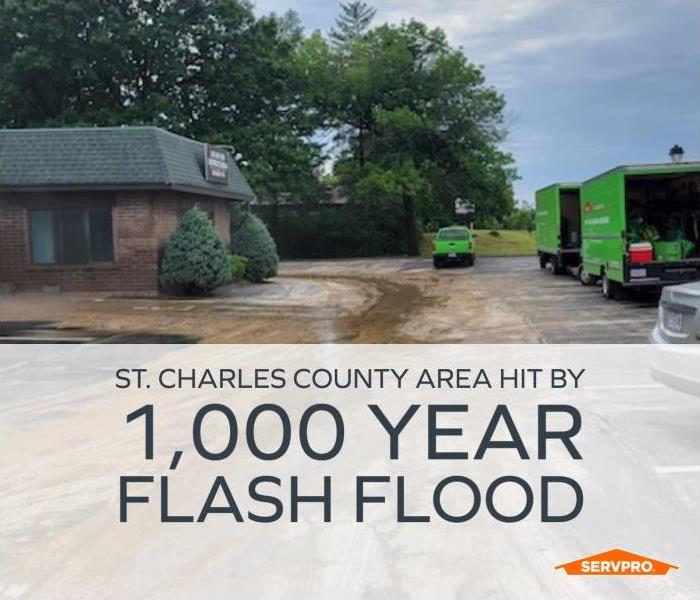 If your home or business has been affected by the recent flooding, we are here and ready to help. Give us a call today.
If your home or business has been affected by the recent flooding, we are here and ready to help. Give us a call today.
On Tuesday, July 26th, 2022, a complex of thunderstorms set up along the I-70 corridor in Missouri. Several rounds of thunderstorms with rainfall exceeding 2inches in an hour affected this area, including the of St. Peters and the surrounding greater St. Charles, MO area. Upwards of 11” of rain fell in St. Peters, MO and over 8” of rain fell in St. Charles, MO. This rainfall was one of the most significant events since records began in 1874. 7.68” of rain was received in just 6 hours, which has a 1 in 1,000 chance of occurring each year. This also accounts for 25% of the normal amount of rain for July and August combined.
A state of emergency was called Wednesday in St. Charles County. The flooding caused roads to close, homes to be evacuated and left motorist stranded. When the Dardenne Creek Levee breached north of St. Peters in the St. Charles County area, water poured across highway C flooding nearby parks such as Lone Wolff Park. Homes, apartments, and businesses have suffered major water damage. Many have had to abandon their homes and enter shelters.
SERVPRO of St. Charles City has been busy helping those affected by the recent flash floods, calling in additional help from the Disaster Recovery Team. Team Wolfe arrived with a semi full of equipment and trained water restoration technicians to help with the large influx of customers needing immediate help restoring their homes and businesses.
If your home or business has been affected by the recent flooding, we are here and ready to help. Give us a call today.
Source:
July 26th, 2022 Historic Flash Flooding in the St. Louis Metro Area (weather.gov)
St. Charles County issues a state of emergency after flooding | FOX 2 (fox2now.com)
Severe Weather: What To do When Your Attic Floods
5/18/2022 (Permalink)
 If your home or business experiences storm damage to your roof and attic we are here to help.
If your home or business experiences storm damage to your roof and attic we are here to help.
Especially during the spring and summer months, homes and businesses in the St. Charles City area can experience severe weather that could damage roofing including, strong winds, hail, and tree damage. Roof damage can cause water damage in your attic space. Do you know who to call if you experience storm damage?
Often, if you have a large attic in your home, it can be used as a storage area. We understand that while these items are in storage, they are often items you do not wish to part with. Our fast mitigation response time will allow us to prevent additional unnecessary damage to these items.
When your roof experiences damage, water can leak into your attic and ceiling and even cause water damage throughout your property. SERVPRO of St. Charles City not only provides restoration services for water and storm damage, but we can also provide emergency services to help prevent additional damage.
Repairing your roof or any damage to your home is a priority but keeping the water out until final repairs can be done is even more important. We also have a wide range of building services to help prevent additional damage. Using tarps or boarding up openings and windows are our first focus and allows us to begin restoration. We use equipment such as air movers and dehumidifiers to quickly dry your property.
We also offer build back services and can help with reconstruction needs your property may have after the severe weather. Once restoration is complete, we can transition to construction.
We are no stranger to damage from severe storms and are ready to help quickly when you need us most. We are available 24/7, 7 days a week. Give our SERVPRO of St. Charles City team a call today: (636) 926-0033.
Preventing Storm Damage
4/6/2022 (Permalink)
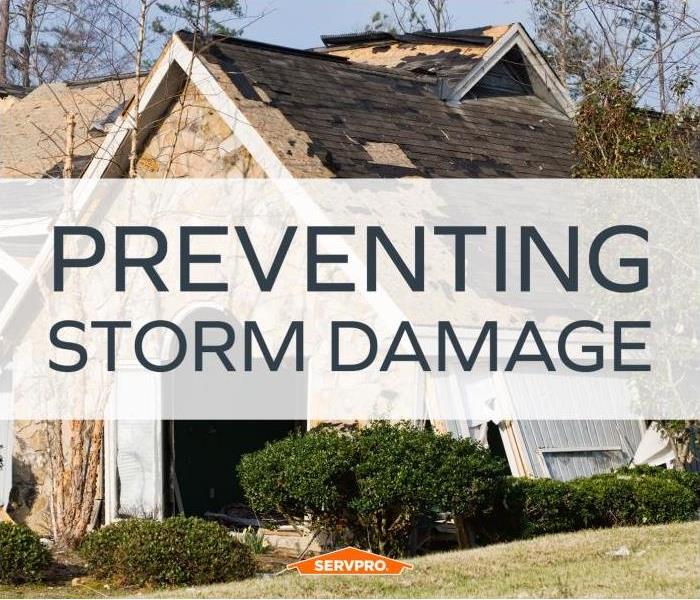 Wherever you find a storm you’ll find SERVPRO green trucks and green shirts. Our motto emphasizes our work: “Faster to any size disaster."
Wherever you find a storm you’ll find SERVPRO green trucks and green shirts. Our motto emphasizes our work: “Faster to any size disaster."
Every spring, we in the Midwest prepare for the season of storms. Unfortunately, many of us end up dealing with the damage caused by these natural disasters.
Despite the weather's unpredictable nature, there are still a lot of things that homeowners can do to protect their homes and property.
What can you do to help minimize storm damage? A little can go a long way.
Here are a few easy items to inspect before the next storm hits:
- One of the most important steps that homeowners can take is to replace damaged or missing shingles.
- Loose siding? The same rule applies, it’s important to ensure that your siding isn’t damaged.
- Keep the gutters clear. Even if you cleaned the gutters in the fall, make sure to double check that they are still clear this spring. This will help keep the water flowing away from your home.
- Inspect your property to make sure water from gutters and runoff will be flowing away from your home. The grade of the lot should work to move water away into a ditch, drain or other retention area.
- Check your sump pump. We have a helpful blog post you can view to help with this one: Sump Pump Checklist.
- Are your windows and doors properly sealed? In the event of tornadic winds, a small opening can allow enough wind inside to comprise the roof.
- Trim your trees. Regular trimming of the trees on your property can also help protect your home and property.
- If you know a storm is coming, you may not have time to make repairs on everything listed above, but simply identifying items that can become projectiles and cause damage can help. Take a walk around your property and move lawn furniture, tools, flowerpots, or any other yard debris into your garage, shed, or indoors.
While these steps may help save your property, the most important step keep your loved ones safe. Have a storm safety plan in place, including a safe location, like a basement or storm shelter, to ride out the storm.
When the storm is over, inspect your property for any damage. If damage occurs, SERVPRO of St. Charles City is ready to help. Wherever you find a storm you’ll find SERVPRO green trucks and green shirts. Our motto emphasizes our work: “Faster to any size disaster." We specialize in helping families and businesses recover after small and large storms.
Have Storm or Flood Damage? Call Us 24/7: (636) 926-0033
Easy Steps to Prevent Storm Damage
1/18/2022 (Permalink)
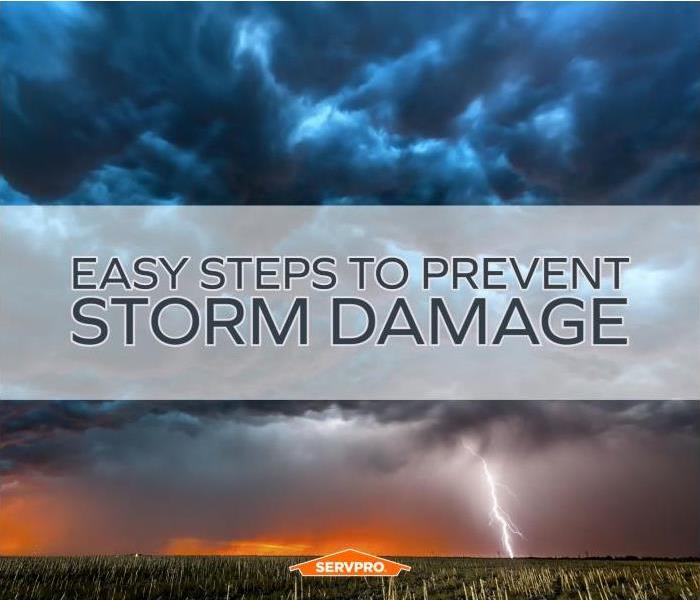 If your St. Charles area home or business experiences damage from a storm, SERVPRO of St. Charles City is here to help.
If your St. Charles area home or business experiences damage from a storm, SERVPRO of St. Charles City is here to help.
While severe storms typically happen during the spring and summer season, it’s anyone’s guess when a severe storm will occur. We can often experience severe storms at any time, causing property damage to your St. Charles, MO home or business.
There are a few steps you can take to help prevent damage to your home, with many being part of your basic upkeep. However, they can go a long way in minimizing damage.
- Replace Missing/Damaged Shingles
- Damaged shingles are more likely to break free. Missing shingles leave a gap for wind to get under and do more damage. If your roof gets a leak from missing shingles, it can cause water damage.
- Keep your gutters clear and ensure water moves away from your home.
- Keeping your gutters clear allows water to flow freely and not back up. It’s also a good idea to make sure that your down spouts flow away from your home.
- Ensure the grade of your property keeps water away from your home, and instead flows into a ditch or other retention area.
- Check Your Sump Pump
- Before a large rain, double check your sump pump is in working order. For extra security, having a backup sump pump is a great way to prevent basement flooding.
- Identify Items that Could Become Projectiles
- Secure outdoor patio furniture or loose items that can be blow away by the wind. Look for lawn decorations, tools, flowerpots, etc. Secure these items in garage, shed, or indoors.
- Anything that’s not secured can be a liability, even loose fence posts. Fence posts are often overlooked when preparing for severe weather. Give each one a shake to check for loose ones.
- Trim Your Trees
- Tree limbs near your home, vehicles, or even your neighbors’ trees can cause damage to your home. Make sure to trim your trees regularly.
- Get a Generator
- A bad storm can knock out power for a few hours – or days. Having a generator can go a long way in ensuring you don’t lose your food and can stay in your home.
One of the most important tasks is to protect your family. Have a storm safety plan in place, with a safe location to go to ride out the worst storms. Have an emergency kit with medical supplies, water and food for a few days is also essential for your safety plan.
Storms can bring a lot of uncertainty, but you can depend on SERVPRO of St. Charles City to help if you experience storm damage. Give us a call, 24/7, 7 days a week – (636) 926-0033.
Does A Business Need Flood Insurance?
11/11/2021 (Permalink)
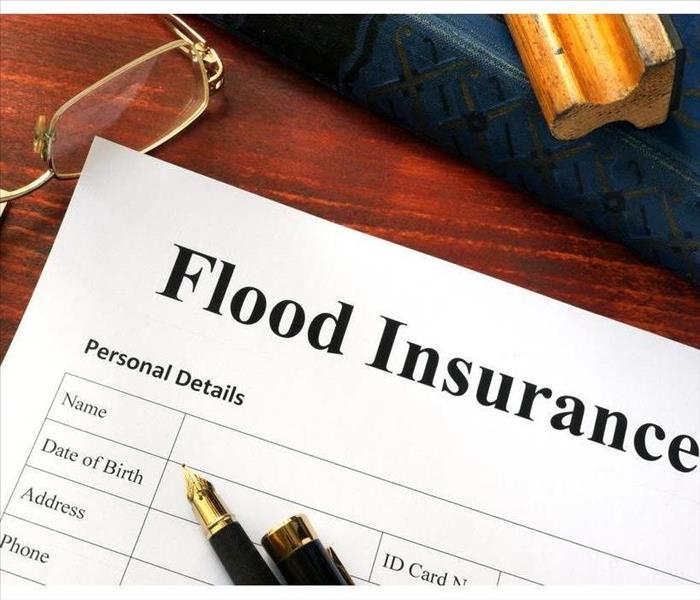 Flood insurance may protect against losses caused by flooding.
Flood insurance may protect against losses caused by flooding.
Flood Insurance For Your Business
Flood insurance is a useful tool to combat the risk of natural disasters, but many business owners do not understand the requirements and basics of these potentially valuable policies. Keep reading for clarification and consideration.
1. Is Insurance Necessary?
While commercial insurance is likely mandatory, coverage for flooding may only be required in some regions of the country. However, just because it is not required does not mean it is not necessary. Only you can be the judge of the necessity of this type of insurance. If your business is located in a low-lying area or an area prone to even small floods, it may be a nice addition to your policy.
2. Does Insurance Protect Against Losses?
Flood insurance may protect against losses caused by flooding. However, there may be specific requirements for that coverage to kick in. For instance, your flood policy may make a stipulate that the flooding is caused by a natural disaster, like the overflowing of lakes, rivers, or streams. Some plans may require an overflow to be a certain size before being labeled a flood. For example, many policies agree that water must cover a minimum of 2 acres or affect a minimum of 2 properties before being defined as a flood.
3. Does Insurance Cover Landscaping and Exterior Property Damage?
No, most flood policies do not cover damage done to the exterior of a property, including landscaping and septic systems. Additionally, business interruptions will likely not be covered by this type of policy. There are policies for business interruption as well as additional endorsements that can expand coverage to things like vehicles.
4. Does Insurance Cover Restoration?
Yes, if you have flood coverage, most policies will cover the costs of business restoration. While each policy is different, most will require that you receive a minimum of 3 estimates from restoration companies in St. Charles, MO, area.
While every municipality does not necessarily mandate flood insurance, it may be beneficial for business owners. Ensuring that your property is protected against every potential risk is a way to preserve and maintain operations. Right, not every business needs flood protection, but it may be worth considering.
4 Tips for Traveling During Storm Season
10/23/2021 (Permalink)
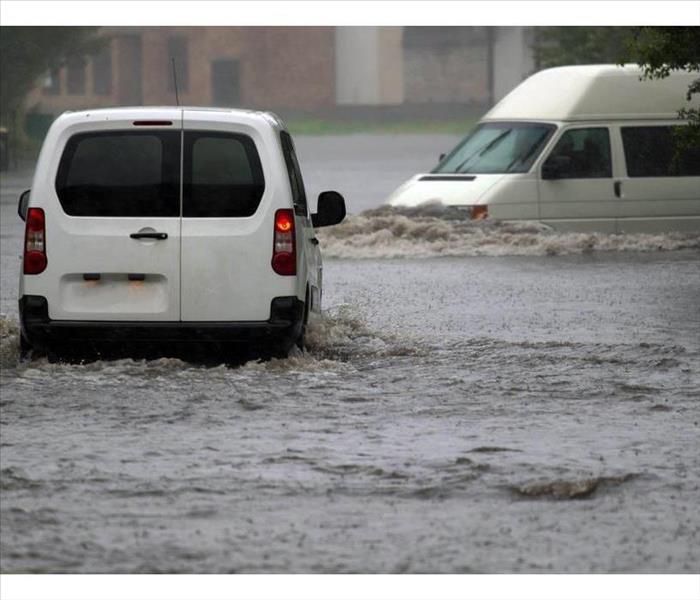 Don't drive on a flooded street.
Don't drive on a flooded street.
4 Travel Tips During Storm Season
Storms can happen any time in St. Charles City. Heavy rains and strong winds can cause damage to your home, but they can also affect your ability to travel. While a storm remediation service cannot help fix your travel plans, it can help repair any damage done to your home. If you want to travel, however, you can remember these four tips to help you avoid a canceled flight and have the best trip possible. Have a Backup Plan
Planning a trip during storm season can be risky, but you don't always have a choice. If you must fly when bad weather is likely, try to have a backup plan ready. This could include buying a travel insurance plan to help you reserve a new seat if your original flight is canceled. You may also want to consider having alternate travel dates in mind just in case.
Get to the Airport on Time
Even if you get an email telling you your flight has been delayed, you may still want to get to the airport in time for the original flight departure. The weather may clear up, which could allow the flight time to be moved back up. If you end up with a canceled flight, you are already at the airport to figure out a new travel plan.
Know Who To Call
Before you get to the airport, you may want to find out who you would have to call should your flight get canceled. Calling the airline directly can help you figure out a new flight if yours gets canceled. You may be told to go to the airline desk, but that will leave you waiting in line for who knows how long.
Pack Light
A canceled flight could require you to quickly change your travel plans. If you have to check bags, there's a chance you may lose some of your luggage in the shuffle. Keeping everything in carry-on bags ensures you can keep track of all of your belongings.
Traveling any time can be stressful. Keeping these storm tips in mind can help you have a great trip.
Storm Shutters: The Simple Investment That Could Save Your Home
8/6/2021 (Permalink)
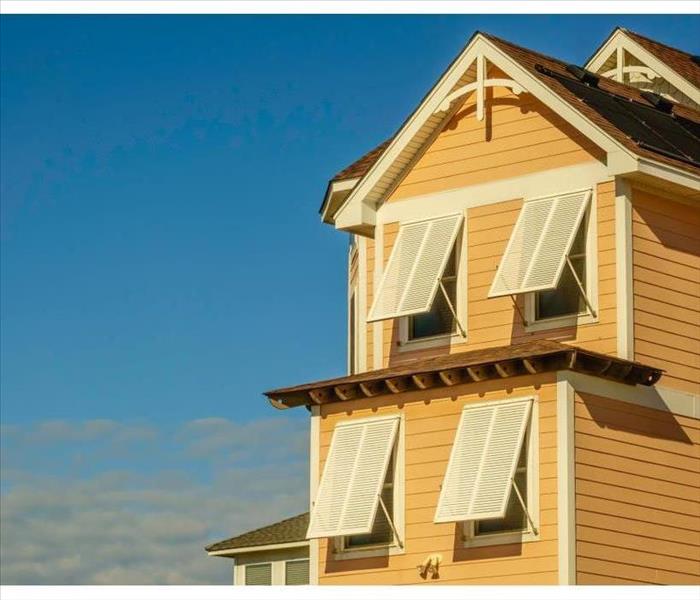 For the next storm season, invest in durable, protective shutters for your home.
For the next storm season, invest in durable, protective shutters for your home.
Storm Shutters
Sometimes it's hard to tell what preventative measures are necessary to protect your home from a natural disaster. However, high winds and hurricane damage in the past few years have cost Americans several billion, and unprotected windows can result in expensive damages:
- Broken windows
- Flooding
- Mold from water seepage
Is There Stylish Protection for My Home?
Thankfully there’s a simple solution to combating the effects of such damaging weather: storm shutters, which come in a variety of styles to fit everyone’s home décor (and budget):
• Accordion: Simple and straightforward to use, these manually folding shutters are available in strong materials like metal or polycarbonate.
• Bahama: This stylish variety not only provides protection from heavy rain and high winds, but also from the sun.
• Colonial: Protect your dream home with traditional blinds that frame your windows and add value to your property.
• Rolling: Prepare for a storm with ease with shutters that unroll or hide away at the press of a button.
How Do Storm Shutters Help?
All of these different options are permanent home fixtures that come in a range of materials, colors and designs. They’ll protect your home from flying objects, heavy rains and strong winds, so you won’t have to worry about damage to your windows or your home interior. Storm damage can be as minor as a few broken windows or as severe as flooding or mold.
Is There a Shutter for My Budget?
Most styles range between $15 and $30 per square foot of window area or anywhere between $200 to $1,000 per window. While installing storm shutters may seem like a daunting task if you have several windows, being proactive about protecting your home from high winds in St. Charles, MO, is extremely important and can save you thousands.
What if My Home Has Already Sustained Damage?
If your home has already sustained storm damage, contact restoration experts to ensure that it is thoroughly cleaned and restored. In the meantime, prepare for next season’s storms by investing in durable, protective shutters for your home.
What To Put in Your Commercial Building's First Aid Kit
5/18/2021 (Permalink)
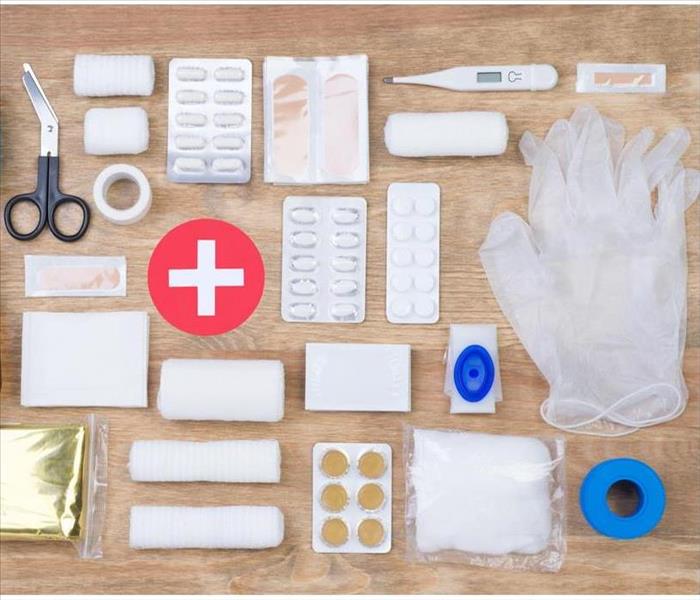 First aid kit supplies.
First aid kit supplies.
Items You Should Purchase For Your Kit
Every commercial building owner needs a first aid kit. In fact, the Occupational Safety and Health Administration requires businesses to keep one of these kits on the premises at all times. The items in the kit can be used to treat a variety of injuries, such as:
- Cuts
- Sprains
- Scrapes
- Burns
While these types of ailments can occur at any time, they are particularly common during storms and other emergencies. Making sure your kit is fully stocked is thus a key part of disaster preparation. Below are some important items you should purchase for your kit.
Basic Essentials
No matter what type of business you own, OSHA-compliant kits must include a box of Band-Aids, a splint, latex gloves, a pair of tweezers, scissors, adhesive tape, disinfecting pads and two triangular bandages.
OSHA also requires other items that may not immediately come to mind. For instance, you need to put a blanket in your first aid kit. This could keep a hypothermic employee warm during a winter storm before first responders and emergency restoration professionals arrive at the scene.
In addition, you may not know that the gauze in your emergency kit needs to be a certain size. To meet OSHA regulations, the tape must be at least 2 inches wide, and the pads must include 4-by-4 inch and 8-by-10 inch varieties.
Business-Specific Items
You may also want to put items in your kit that your specific business could need. For instance, if you own a childcare center, you can pack kid-friendly bandages and adhesive tape for dressing infant cuts.
Meanwhile, if an earthquake or windstorm hits a restaurant, hot food could go flying and cause severe burns. If you own an establishment that serves food, you should thus keep plenty of burn dressings in your kit.
A storm can cause lots of damage to your Portage Des Sioux, MO, property. The shattered glass and broken desks could injure your employees, as well. With a full first aid kit, you can provide immediate medical assistance to hurt workers until help arrives.
How to Develop a Business Continuity Plan After a Storm
4/7/2021 (Permalink)
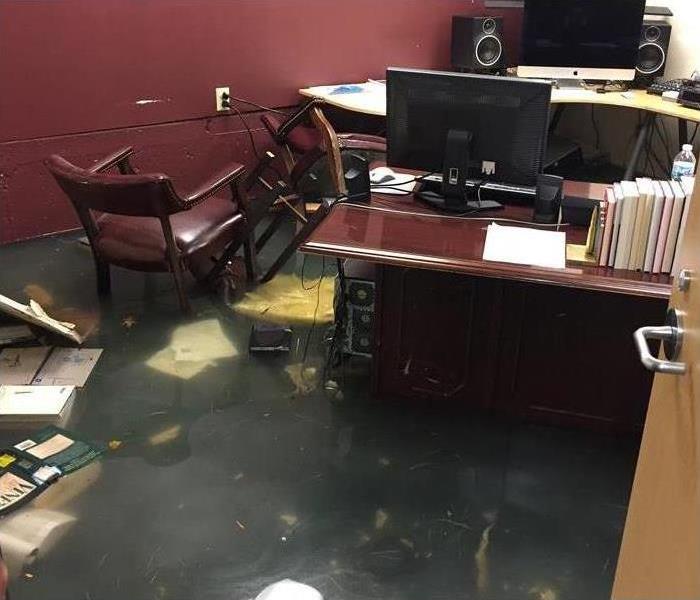 Flooded office in O'Fallon, MO.
Flooded office in O'Fallon, MO.
Prepare Your Business For A Storm
Storms and flooding can strike very suddenly in O'Fallon, MO. While some predictions can be made about widescale storms, others come without warning, and the results can be a disaster for a community – and spell bankruptcy for a business.
Fortunately, you can act proactively and prepare for problems. There are three critical steps to build resiliency in your business:
- Get a commercial insurance policy.
- Develop a continuity plan.
- Keep key personnel informed.
Know Your Insurance Coverage – and Its Exemptions
Insurance policies can be confusing. Make sure you ask your agent about what is and isn’t covered. If you want flood coverage, you’ll need a separate flood policy https://www.fema.gov/flood-insurance .
Establish a Business Continuity Plan
The U.S. Government maintains a website to help citizens and businesses prepare for disasters. They have a detailed description of how to develop your plan, beginning with the business impact analysis.
This starts with a risk assessment to determine what’s high risk for your location and type of business. Are you in a high-risk flood zone? Do you rely on digital information or is everything local? Which natural disasters are most likely?
Which Disaster Is Most Likely – or Most Harmful?
Aim for the most probable disasters based on your BIA. For disasters unlikely in O'Fallon, MO, it may not be worth detailed planning, but general disaster planning can have wide-reaching benefits, even in unforeseen situations.
Key Personnel Should Be in the Loop
The key to resiliency after getting storm damage is to get reopened as soon as possible. Most small businesses will fail within two years if they’ve been closed for more than a couple of days after a disaster. Immediately after the storm, every essential person should be contacted and information shared.
You need to discuss what resources you need to reopen as fast as possible after the storm passes. Calling a commercial restoration specialist immediately after a storm can also be the difference between surviving the disaster and never reopening. Speed is essential, so your restoration company will work with you to get reopened as soon as possible.
With an established continuity plan and good insurance, you can survive the storm and get back to business quickly. Every day you’re closed increases your risk of staying that way.
The Dangers of Black Water
1/15/2021 (Permalink)
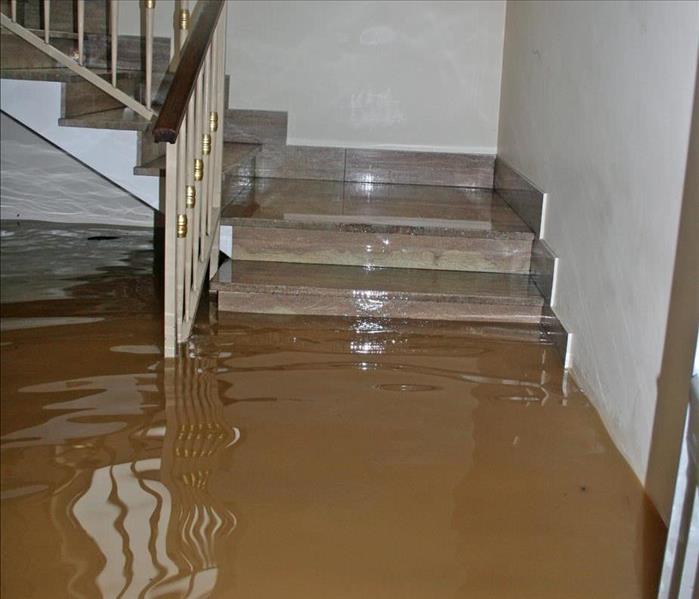 Flood damage to a home in O'Fallon, MO
Flood damage to a home in O'Fallon, MO
Water is categorized into the colors white, grey, and black depending on the substances it contains or has been in contact with. Blackwater is the most dangerous and can cause the most water damage.
What is Black Water?
This category of water can contain:
- Urine
- Feces
- Toilet paper
- Toilet water
- Pathogens
- Cleansing water
It usually comes from toilets and is more commonly referred to as sewage. It is more dangerous than greywater, which usually comes from sinks and appliances, and white water, which is considered pure or clean.
What are the Dangers?
This water carries bacteria and other pathogens that can be harmful. You should avoid any contact with contaminated water. A flood of this category will likely result in more water damage because anything it touches should be considered contaminated. This means items such as carpet, rugs, curtains, and clothing must be disposed of or thoroughly cleaned by a professional. It is also more difficult to clean since using fans or heating systems to dry the area can spread potentially harmful pathogens. Like all flooding, it can also cause molding if it is not properly treated.
What Should You Do?
If you have any contaminated water in your home, you should contact an emergency restoration service in O'Fallon, MO, immediately. They will be able to remove the sewage, dry the area, repair structural damage, and treat the area to prevent molding. They may also be able to clean and restore any belongings that were damaged or contaminated in the flood.
You should not try to clean up the water on your own, as you may expose yourself to harmful substances. Professionals will have appropriate protective gear that allows them to clean it up safely.
Blackwater contains potentially harmful waste and microorganisms and can result in a high amount of contamination and water damage. Floods of this category should always be treated by a professional in O'Fallon, MO.
3 Helpful Tips for Preventing Water Damage in a Storm
11/13/2020 (Permalink)
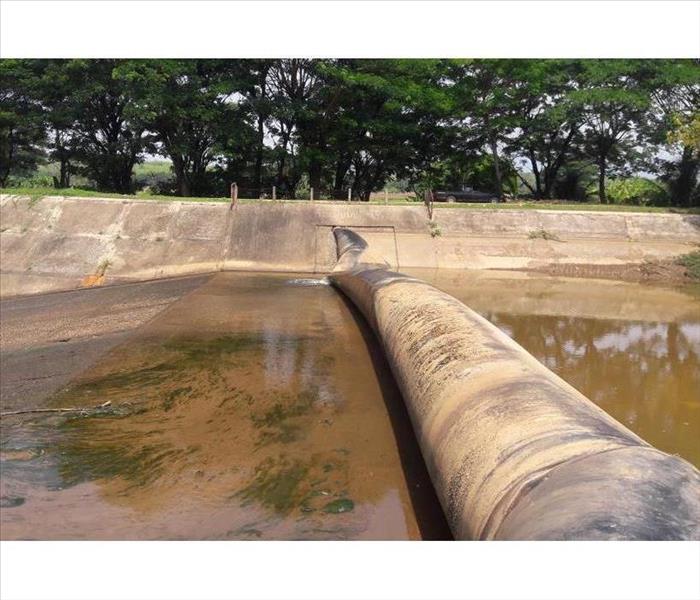 One protective strategy is setting up flood-prevention equipment
One protective strategy is setting up flood-prevention equipment
Tips For Preventing Water Damage In Your Property
Even storms that don't come with severe winds and hail can cause damage to buildings if precautions are not taken. Rain damage from heavy rainfall and the growth of black mold and other harmful molds as a result of moisture buildup are examples of other ways storms can harm property; these can render contents of buildings irreparable and create the need to hire a professional cleanup and restoration service. There are some steps that can be taken to help prevent water from wreaking havoc on property. Here are three helpful tips for preventing water damage in your property in St. Charles, MO.
1. Set Up Flood Prevention Equipment Water damage is a major concern in severe weather whether that be from rain itself or from rising water built up from rain. It is best to take actions to prevent flooding in the building. One protective strategy is setting up flood-prevention equipment:
- Quick dam barriers, or waterless sandbags, react to contact with approaching water, absorbing it.
- Dikes can be used to redirect water
- Absorbent socks can be set against doors, windows and any other place with cracks where water may leak in
2. Perform a Regular Inspection
Another preventative measure is to have a regular inspection of the building done. You should have it checked for cracks in the roof, walls and siding where rainwater could leak in and have those cracks sealed. Having seals placed around windows, doors and areas where cables, vents and pipes enter the wall is also a good move.
3. Have a Strong Building Envelope
A strong building envelope around the building is also a way to prevent rain damage. Technically, every building possesses one. The building envelope consists of the roof and walls (above ground and below ground). Ensuring that the roof and walls are strong and maintained well is one of the best ways to prevent rain penetration during a storm.
Keeping water out is important for preventing buildings from getting rain damage and potentially harmful mold growth.
Types of Flood Water Contaminants
10/27/2020 (Permalink)
 Floods are classified according to one of three categories
Floods are classified according to one of three categories
What Type Of Water Is Flooding In Your Home
While all types of floods are capable of inflicting massive amounts of water damage on your property, some are just inherently more dangerous than others. Floods are classified according to one of three categories, depending on which types of contaminants are present in the water. Read on to see which type of water is flooding your home in O'Fallon, MO.
1. Category 1: Clean Water Floods
Much like the name implies, Category 1 floods are characterized by an absence of contaminants. It is possible for these types of floods to transform into more dangerous varieties if outside contaminants are introduced to the water. Clean water floods are typically caused by:
- Supply line bursts
- Leaky pipes
- Rain water or snow melt
2. Category 2: Gray Water Floods
Category 2 floods do contain mild amounts of contamination, but not enough to be considered a biohazard. If left untreated for 48 hours, a Category 2 flood can quickly become a Category 3. Gray water floods are usually a result of:
- Sump pump failures
- Malfunctioning household appliances, such as dishwashers and washing machines
- Broken aquariums
3. Category 3: Black Water Floods
Category 3 floods are the most dangerous types of floods. They're categorized by the presence of human/animal fecal matter, raw sewage, dangerous chemicals and other types of biohazards. These floods are extremely dangerous and can inflict massive amounts of water damage, so you should never attempt to remediate them on your own. They're often caused by:
- Toilet back flow
- Sewage overflow
- Rising groundwater
- Overflowing banks from rivers or streams
It's important to take all types of water damage seriously, but you need to be especially wary of damage caused by black water floods. If not treated properly, the situation will only get worse and worse. It's best to contact flood remediation experts if your property has been affected by Category 3 flooding.
What Property Managers Should Know About Storm Preparedness
9/1/2020 (Permalink)
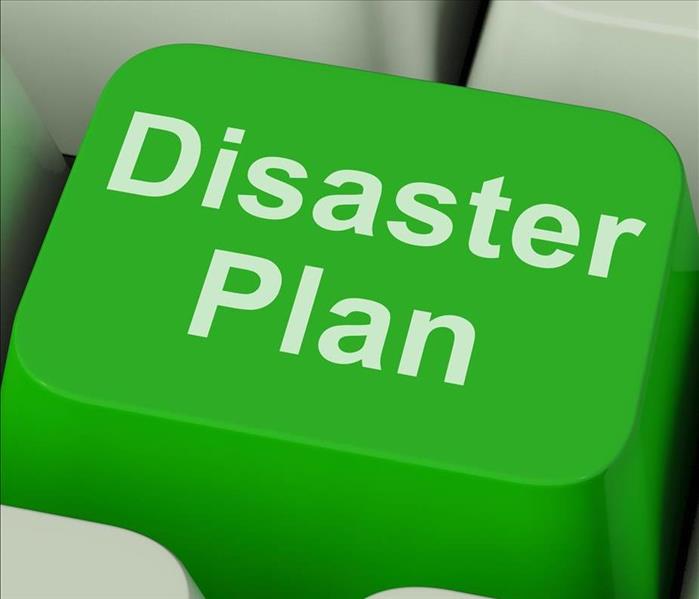 A disaster recovery plan is a fundamental part of great property management
A disaster recovery plan is a fundamental part of great property management
Prepare Your Business From Storm And The Aftermath
As a responsible commercial property manager, you should have a detailed plan before the storm season starts. While there should be insurance policies in place to help cover storm damage losses and a complete water cleanup plan, storm preparedness also includes a thorough recovery plan. From staffing to security to documented procedures, there are many elements to a comprehensive recovery approach that requires detailed and careful planning. If you find yourself facing an approaching weather event in Weldon Spring, MO, you’ll be glad that you took the time to prepare for the storm as well as the aftermath.
Developing a Disaster Recovery Plan
A disaster recovery plan is a fundamental part of great property management. While a storm preparedness plan varies from place to place, it should include these elements:
- Master contact list, which includes emergency response numbers
- Communication protocols, including an alert system for tenants
- Service contracts review, to determine what services are available during recovery
- Safety and emergency procedures checklists
- Identification of emergency personnel
- Documentation of pre-storm conditions
- Backup of property records and important files
- Review of existing insurance policies for adequate coverage
- Plans in place for contractors to mobilize on critical repairs
Property management staff should work with the owners to prepare a recovery plan as well as take steps to make sure that individual units are made ready to minimize storm damage as much as possible.
Dealing with the Storm Aftermath
While storms and the damage left in their wake are largely unpredictable, a storm preparedness plan can help minimize the time it takes to restore things back to pre-event conditions. A complete inspection and survey of the property is necessary to assess the extent of damages. As the property manager, you should communicate to tenants and other staff regarding the state of the property and information concerning disaster relief. Authorizations and signatories should be in place to expedite repair and restoration work for the most essential elements of the property.
5 Vital Storm Preparation Tips
8/12/2020 (Permalink)
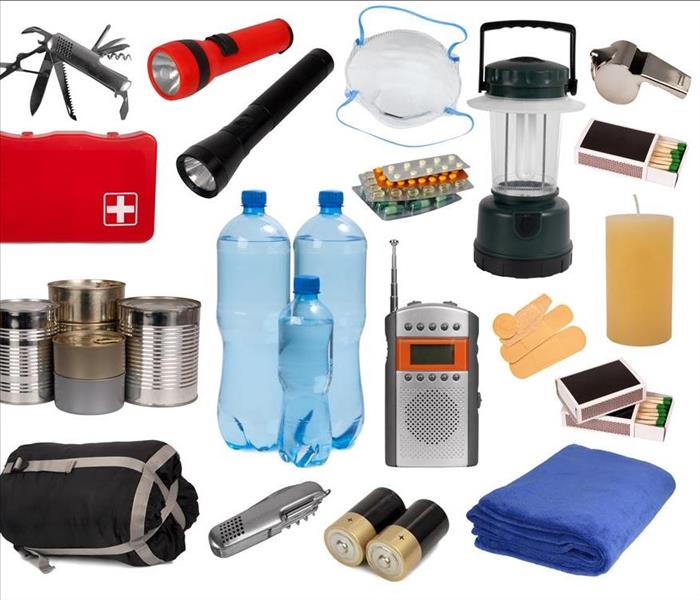 Create an emergency supply kit
Create an emergency supply kit
Ways To Keep Your Home Safe During Storm Season
Hurricanes and other tropical storms can inflict devastating damage on a community. High winds, heavy precipitation, and flood water are only the first of your worries during this time. However, you can reduce your risk by preparing yourself before the storm hits. Follow these safety tips to help keep your home in St. Charles, MO, safe during storm season.
1. Stay informed: The first thing you should do is sign up for your community's emergency alert system. This way, you'll have access to the latest storm updates as they occur.
2. Learn and practice your escape routes: Chances are, your community already has specific evacuation routes mapped out. If they don't, then make sure to take the time to plan your own escape methods. Practice these regularly so you'll be ready in case of an emergency.
3. Create an emergency supply kit: Your emergency supply kit should contain everything you need during an emergency. Your kit should contain freshwater, non-perishable food items, a first aid kit, a flashlight, extra batteries, a wrench and/or set of pliers, and a backup cell phone, at the very least.
4. Keep electronics away from flood water: The most dangerous part of any flooded building is electrified water. Move all electrical equipment, such as wiring, and circuit breakers at least one foot above flood level.
5. Never enter the flood: You should never, under any circumstances, attempt to swim, walk-in, or drive through floodwater. You may think you're a strong swimmer, but the flood is definitely stronger. It only takes six inches of moving water to knock you off your feet. Additionally, there's always a chance that the water could be contaminated, which poses a dangerous health risk.
Preparation is an essential part of staying safe. Possessions can be repaired or replaced, and are never worth risking your life over. After the water has subsided, and the authorities have given you permission to return to your home, you should contact storm remediation experts to help assist with the water damage.
How To Identify the Type of Water Damage in Your Home
4/29/2020 (Permalink)
 What are the three types of water categories?
What are the three types of water categories?
Water damage is a very serious issue to deal with in your home in St. Peters, MO during a storm. It’s also important to realize that there are different classifications of water contamination. Listed below are the different categories, along with some storm tips for how best to handle them.
What Are the Three Types of Water Contamination?
Clean water: Category 1 - This is water that originated from a fresh water source, such as a burst water pipe or a leaky faucet. The water starts out clean, but if not removed quickly it can become contaminated by other materials and escalate into a more serious problem.
Gray water: Category 2 - Any water that has leaked or overflowed from a dishwasher, washing machine, or feces-free toilet would fall into this category. The water may potentially contain bacteria so it should be dealt with quickly or it could become a category 3 problem.
Black water: Category 3 - Flooding that originated from streams or rivers is considered black water. Sewer backup would also be included in this category. Since this storm damage is highly contaminated, you should avoid it and call a professional immediately to handle the water cleanup.
How Can You Mitigate the Water Damage?
If the living space is flooded, you should leave the house and not return until an expert has assessed the situation. If the water is limited to a small area and you’ve determined that the source was clean water, you can follow these storm tips:
- Use heavy towels or clean rags to soak up the water
- After the water is removed, turn on a dehumidifier or fan to aid in drying the carpet
- Call a professional to inspect for mold
The safest way to handle any kind of storm damage is to follow these storm tips in the interim while you wait for the experts to assess the situation. They will be able to find the best solution for your home.
How To Fix A Leaky Roof
4/9/2020 (Permalink)
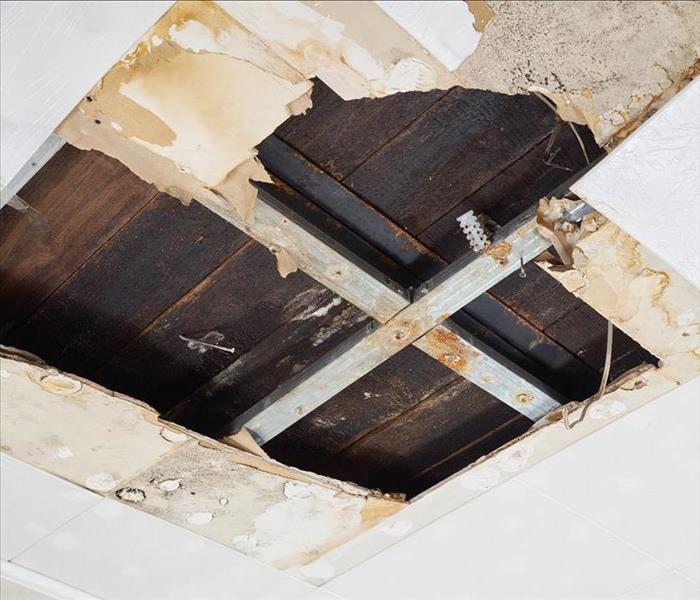 Damaged ceiling panels in a St. Charles, MO building
Damaged ceiling panels in a St. Charles, MO building
Many business owners are too busy thinking about how to manage employees and maximize the efficiency of their operations to consider the roof of their commercial building. A nasty roof leak can derail an enterprise, however, especially during a storm. Fortunately, it’s possible to prevent the devastating consequences of a damaged roof with the right preparation.
Know the Signs of a Problem
People often don’t realize that their roof is leaking until they notice water dripping from their ceiling. There are several subtle indicators of a leaky roof, including:
- Ceiling stains
- Mold or algae growth
- Buckling, curling or missing shingles
Business owners don’t have to take care of these issues during storm cleanup. They can start early and inspect their property for a roof leak before a problem gets out of hand. A sturdy roof is one less problem to worry about in the aftermath of a vicious storm, especially since it’s common for property owners in St. Charles, MO, to deal with accompanying flood damage as well.
Trust the Professionals
Commercial building restoration professionals specialize in revitalizing properties from storm damage to make it “Like it never even happened.” They’re trained in a variety of cleaning techniques to eliminate moisture and bacteria in your roof as well as all the interior areas that suffered from unwanted water and debris.
Professionals can get to work in little time and complete every step from pumping away stagnant water, disinfecting and drying a damaged area, and replacing shingles, wallpaper and carpet. They collaborate with insurance to ensure that your costs are as low as possible. Once you see the level of quality that restoration professionals in your area bring to every project, then you can feel confident contacting them for future emergencies. If inclement weather is a yearly occurrence, then it’s a great way to obtain peace-of-mind over things that you cannot control.
A roof leak and the subsequent flood cleanup requires worries many business owners, but it doesn’t have to be this way. Early detection can prevent expensive damage to your property.
How To Deal With a Sewage Backup in Your Home
11/16/2019 (Permalink)
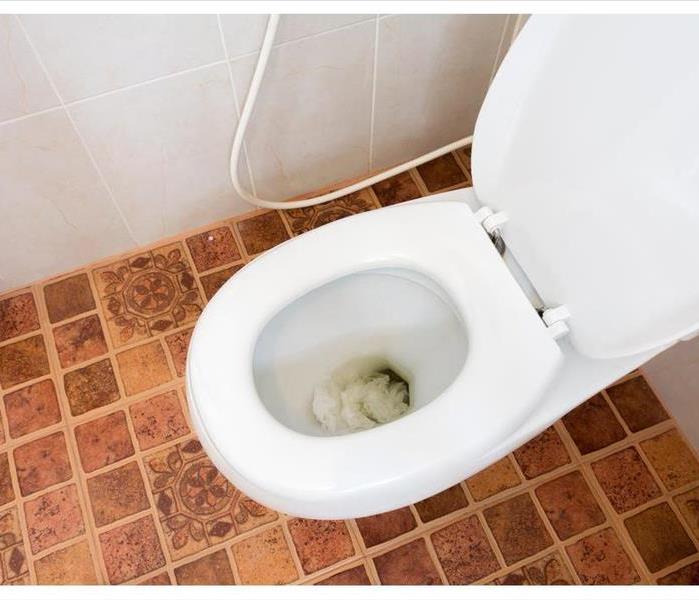 A toilet clogged can cause a sewer back up in your home
A toilet clogged can cause a sewer back up in your home
If your home in Weldon Spring,MO is your castle – a place of safety and comfort where you can spend time with your family in learning, loving and relaxing – the last thing you want to think about is a backed-up sewer. The contamination and odor are bad enough, but resolving the problem can be complicated and cleaning a sewer-flooded basement can be a nightmare.
What Causes a Sewer Backup?
There are several things that could make a sewer back up – some reasons are due to people’s actions, some are due to natural causes. This list will help explain some of the possible reasons.
Someone nearby flushed something that created a major clog, such as a diaper, a toy or some clothing, for example
Roots have grown into the main line, constricting the flow
Water has backed up into the sewer lines due to storms causing a flooded basement
A line may have broken due to frost heaves or for other reasons
What Should You Do?
If you see water coming up out of a floor drain or backing up in your toilet, call for help immediately, as it could be something serious requiring special equipment. Try to barricade the flooding if possible with rolled up towels or even sand bags in order to contain the contamination. Sewage contains not only human waste, but can also carry chemicals and toxins, so special care should be taken to keep it from spreading.
Proper Cleanup
Get help from a sewage and water restoration company in Weldon Spring,MO to use appropriate disinfectants, dispose of contaminated materials and make sure that things are safely clean. Any carpet, rugs or upholstered furnishings that were exposed to sewage water will likely need to be disposed of. Non-porous surfaces may be cleaned and disinfected.
A backed up sewer is no laughing matter, but understanding how to safely clean and restore a flooded basement can keep it from becoming catastrophic. Act quickly and get help as needed to minimize the damage.
How To Clean Up a Leaking Roof
10/30/2019 (Permalink)
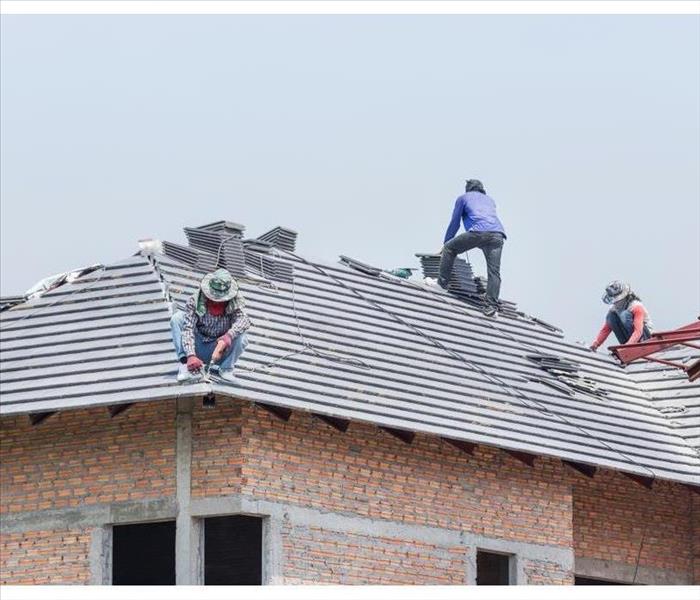 Maintaining your commercial building is essential, especially if it’s a major business investment
Maintaining your commercial building is essential, especially if it’s a major business investment
How To Clean Up a Leaking Roof
Discovering a roof leak in O'Fallon,MO, is probably on the list of least-desired problems a commercial building owner can deal with, especially if you’re not sure when it started. If you suspect that the leak occurred a few days or weeks ago, perhaps going unnoticed while you were out of the office or not using that part of the building, you might discover more damage than anticipated such as:
- Mold
- Rotted wooden trusses or beams
- Pooling water, causing bacteria growth
- Electrical damage
- Soaked insulation
Knowing what to do in these situations is critical to preventing additional structural damage.
Stop Leaks and Remove Wet Materials
If there is an active roof leak, you should first contain the leak with buckets or towels. If you notice bulges in the ceiling, this could cause a collapse at some point. If it is safe to do so, poke a hole in the middle of the bulges to release the water. It is better to have a professional do this for your safety.
Then, begin removing belongings and other easily removable items from the area. Any materials, such as dry wall and damaged flooring can be torn out by a flood restoration company.
Dry and Disinfect Area
The flooded are must then be completely dried and disinfected if necessary. If any moisture is left behind, you could develop a mold problem very quickly. Roof leak restoration companies utilize professional drying equipment, which is very thorough at removing all moisture, including inside walls.
Depending on how long it took to begin the cleanup process, there may already be mold or bacterial growth. Disinfection is necessary to ensure no spores or bacteria are left behind.
Restore Roof and Ceilings
Once the area is completely clean and dry, you can begin to restore your damaged roof. Utilizing the services of a professional company is ideal in these circumstances, because they are able to determine the structural safety of the building and what types of repairs are needed to bring your building back to how it was before the flood.
Protect Your Investment
Maintaining your commercial building is essential, especially if it’s a major business investment. If you notice missing shingles or roof damage, it is best to make repairs sooner rather than later, so you don’t end up with another flooding problem in the future. If you have discovered a leak, also make sure to document and photograph damage and repairs for insurance purposes.
5 Ways To Prevent Sewage Backups
9/9/2019 (Permalink)
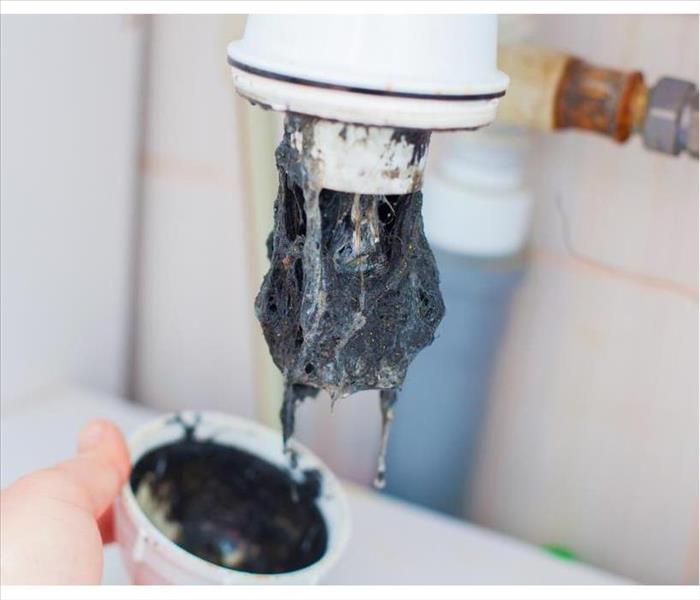 Do your best to prevent hair from traveling down your drains
Do your best to prevent hair from traveling down your drains
5 Ways To Prevent Sewage Backups
Did you know flooding in Weldon Spring,MO, can cause a sewer backup? To help prevent this common form of storm damage from occurring in your home, follow these tips.
1. Trash It, Don’t Flush It
Backed-up sewage is often caused by blocked pipes. Certain household items can contribute to this, and should never be flushed down the toilet. These items include the following:
- Paper towels
- Wet wipes
- Hygiene products
- Diapers
Even if the packaging says it’s alright, it’s not a good idea to flush them. Be on the safe side and put them in the trash instead.
2. Stop Hair From Going Down the Drain
Hair, especially if it’s long, is another contributing factor to clogs. Do your best to prevent hair from traveling down your drains. You may need to invest in a shower drain cover to catch the hair. If the hair has gone too far, you might even need to snake your pipes.
3. Dispose of Grease Properly
Although grease is a liquid when it’s hot, it quickly solidifies into a thick, pipe-clogging mess when it cools. Grease that is poured down the drain will stick to your pipes and contribute to clogs. Make sure you always properly dispose of grease after cooking to avoid a backup.
4. Keep an Eye on Tree Roots
If you have large trees near your sewer line, contact a professional to inspect the line. They can use a camera to determine if roots are damaging your system. There are solutions available for this problem, but you want to catch it early to prevent a complete block of the sewage line.
5. Act Quickly
If water is draining more slowly in your bathtub or sink, make sure you act quickly to determine the problem. A professional company offering sewer cleaning can help you identify the issue. You can then take steps to ensure the issue doesn’t turn into a messy situation.
Following these tips can help prevent sewage from backing up into your home. In the event you do experience a backup, professional residential cleaning experts in Weldon Spring,MO, are available to clean and restore your space.
Tips for Flood-Proofing Your Commercial Building
8/28/2019 (Permalink)
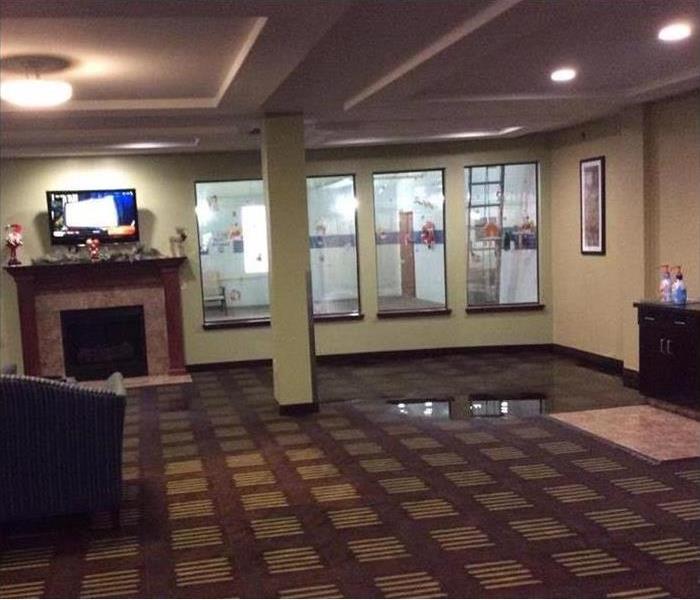 Storm damage in St. Peters, MO
Storm damage in St. Peters, MO
Steps You Can Take To Mitigate Your Damages And Protect Your Assets
A massive flood can destroy your commercial property. It can also put your entire business at risk. The National Flood Insurance Program reports that at least 25 percent of all companies that close due to flood damage never reopen.
Unfortunately, due to global warming, the odds of your company being affected by storm damage have increased in recent years. Even states that are not used to major flooding, such as Texas, have seen weather catastrophes.
If you are a business owner in a flood-prone area, there are steps you can take to mitigate your damages and protect your assets. These options include:
- Elevating your building above flood levels
- Moving your office to a higher location
- Building flood barriers
- Enacting flood-proofing measures
Flood Proofing
Seals, pumps and barriers can help limit flood damage in St. Peters,MO. However, before considering these or other flood-proofing devices, you should perform a benefit-cost analysis to see if the mitigation method you are choosing is cost-effective.
You must also inspect any flood-proofing system regularly to make sure it is working properly. Similarly, you can limit the need for flood cleanup by checking for cracks in your floors and walls before a storm arrives.
Emergency Plan
Besides flood-proofing your commercial building, you can also protect your property and assets by coming up with an emergency plan. The plan should obviously feature evacuation procedures and drills.
The plan should also state where any flood-proofing devices are located and who is responsible for implementing them. You may also want to include steps for keeping essential electrical equipment running if the power goes out.
Flood-proofing measures and an emergency plan can limit the need for storm cleanup. However, even if you properly prepare your building, it may still sustain flood damage. A commercial building restoration services company can help save your assets after a storm and get the office running again.
The Facts About Nor’easters
7/11/2019 (Permalink)
 A nor’easter is a storm in which winds blow in a northeasterly pattern as it heads along the Eastern Seaboard
A nor’easter is a storm in which winds blow in a northeasterly pattern as it heads along the Eastern Seaboard
Facts About Nor'easters
According to the National Weather Service, a Nor’easter is a storm in which winds blow in a northeasterly pattern as it heads along the Eastern Seaboard. These storms occur when cold air from the polar jet stream moves southward from Canada into the U.S., then moves to the east, where it joins the warm air moving up from the Gulf of Mexico. Here are three additional Nor'easter facts.
1. Where Do They Happen?
A Nor’easter can span thousands of miles, developing between Georgia and New Jersey. Most storms begin within a hundred miles of the East Coast. This major weather disturbance usually reaches its maximum intensity near New England and continues into the Maritime areas of Canada.
2. When Do They Happen?
This type of storm occurs any time of the year; however, the most dangerous and violent storms hit between September and April. For seven months out of the year, the East Coast has the chance to be inundated with severe weather that can last for days at a time. In March 2018, for example, four Nor’easters hit the East Coast in three weeks.
3. What Happens During a Storm?
Nor’easters are typically considered to be winter storms, but snow is not a requirement. In the worst of storms, snow can accumulate 1 to 3 inches an hour and cause blizzard-like conditions. Thundersnow is also an occurrence, although it is rare. Heavy, torrential rain and gale-force winds can leave an enormous trail of destruction and devastation.
Billions of dollars in damages can result when a massive storm crashes into your city. Whether you’re from St. Peters,MO, or another part of the U.S., flooding and other water damage is a common occurrence, not only after a Nor'easter, but also after a wide variety of severe weather events. Fortunately, there are storm damage restoration experts near you who can provide tips for protecting your home and help you minimize and mitigate the damage.
Is Dry Flood Proofing an Option for Your Business?
5/11/2019 (Permalink)
Protecting your building from flood damage is a crucial step in avoiding losses during natural disasters or trouble with plumbing systems. Around the country, the risk of flooding is increasing for business owners. There are a few options you can take to keep your St. Charles, MO, business safe from losses:
1. Build on or move to higher ground.
2. Create barriers around commercial structures.
3. Dry flood proof your properties.
Possible Roadblocks
Many business owners, especially of smaller operations, don't have the option of moving their property or setting up from scratch. It may also be difficult to get permission to build new structures if the business front is rented or if the community has specific requirements for new construction. In many cases, dry flood proofing is the most cost-effective route for reducing losses and damage from flooding.
A Proven Strategy
What is dry flood proofing? This strategy for protecting buildings from storm damage involves the use of seals and pumps for a water tight perimeter. The use of barriers is also a component. The U.S. Army Corps of Engineers uses this protective method. As a business owner, you may want to consider the value of this strategy for your own company.
Decision Factors
Guarding against flood damage with dry proofing is a smart move. As you consider the costs and benefits of this solution, there are several factors to take into account:
- Benefit-cost ratio involving factors such as insurance rates and business financing
- Current and future use of buildings and the potential for business disruption
- The safety of occupants on your property, including employees and customers
- Existing flood emergency operation plans
Flood damage restoration professionals can often offer information about your specific community. If a dry flood proofing plan isn't right for your business, consider an alternate emergency operational plan. While working through these steps, schedule routine inspections and ongoing maintenance. Work closely with water damage and remediation experts in your area.
3 Household Problems Caused by Winter Storms
5/10/2019 (Permalink)
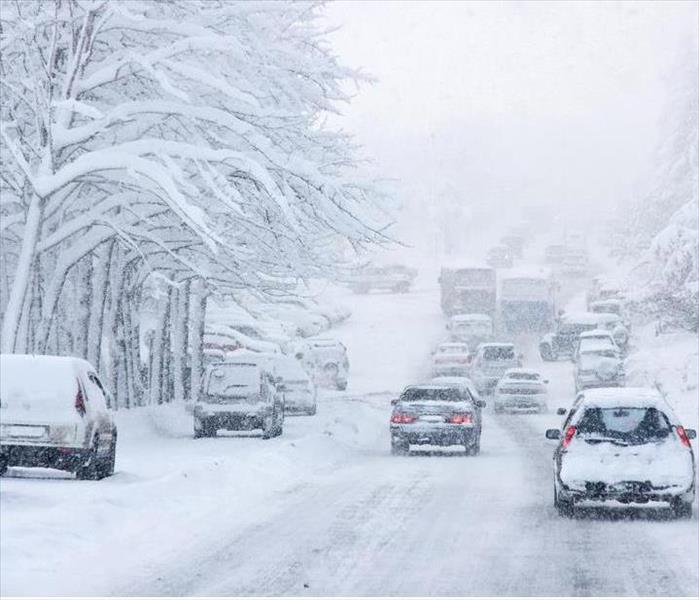 What type of issues can arise after a snow storm?
What type of issues can arise after a snow storm?
Children view a winter storm in St. Charles City, as a break from school and a chance to build a snowman. Homeowners see a blizzard as shoveling and potential disasters. Be aware of the following three winter dangers that may happen to your home.
Roof Damage
During a blizzard snow has the potential to become very heavy, especially when it accumulates quickly. Buildup of snowfall on trees may cause branches to break and crash into roofing. A mere inch of wet snow gathered on your roof weighs in at 20 pounds per square foot, so an epic winter storm may incite a roof collapse. Be sure to consider your safety first, if your roof is compromised it is wise to leave the house immediately.
Flooding
As if a roof collapse isn’t bad enough, snow in the house melts. A lot of snow means a lot of water. Flooding damages the house structure, such as drywall and flooring. It also has the potential to damage your personal property if not dealt with immediately. When flooding is suspected, it is a good idea to contact a water restoration specialist as soon as possible to mitigate and prevent further damage to your home.
Fire
Unfortunately cold, wet weather does not always preclude fire from damaging your home. Storm winds may cause electrical problems or lightning may strike. Use good sense not to leave candles unattended and practice space heater safety. If a fire occurs, relocate to safety and call for help. Oftentimes both fire and water damage from firefighting efforts need to be addressed by a restoration professional after the fire.
When a winter storm strikes in St. Charles City, be knowledgeable about potential hazards and what to do if one occurs. Once you are prepared for the worst, expect the best. Relax, enjoy a hot drink and build a snowman with your family.
5 Ways To Upkeep a Commercial Roof
5/8/2019 (Permalink)
Roof damage or deterioration can be very costly. In addition to the price of materials and labor for repairs or replacing a roof, this damage can also damage building materials and contents. Property owners can follow five simple steps to preserve the condition of a commercial roof.
5 Simple Steps
- Inspect the roof at least twice a year. Make sure you know about potential issues and all of your upkeep options to extend the life of a roof. Do this by having experts perform annual inspections. If you know what to look for, you can do at least one of these inspections yourself.
- Trim trees with overhanging branches. Reducing the number of branches and leaves that accumulate on the roof can help to keep drainage systems clear. Tree maintenance can also prevent heavy limbs from falling in the event of high winds or adverse weather conditions.
- Clear drainage systems regularly. Water that cannot drain may pool and work its way under roofing materials, resulting in leaks. Make sure that leaves and other debris are not blocking downspouts, drains, or gutters, and that drainage is routed away from the foundation.
- Regularly repair minor roofing issues. Extend the amount of time before a roof rebuild by addressing roof damage as soon as it occurs.
- Have your roof waterproofed. Waterproofing can help to prevent cracks and leaks. A roofing service can help you determine the right methods and materials for your property.
A regular maintenance schedule can help property owners address roof damage and wind damage in a timely manner. Keeping an eye on the condition of your roof can extend the life of this part of your building and prevent costly leaks. If a roof sustains damage or deteriorates to the point where the interior suffers water damage, property owners should contact a company in St. Charles City, that specializes in commercial damage restoration.
4 Residential Flood Proofing Tips
4/25/2019 (Permalink)
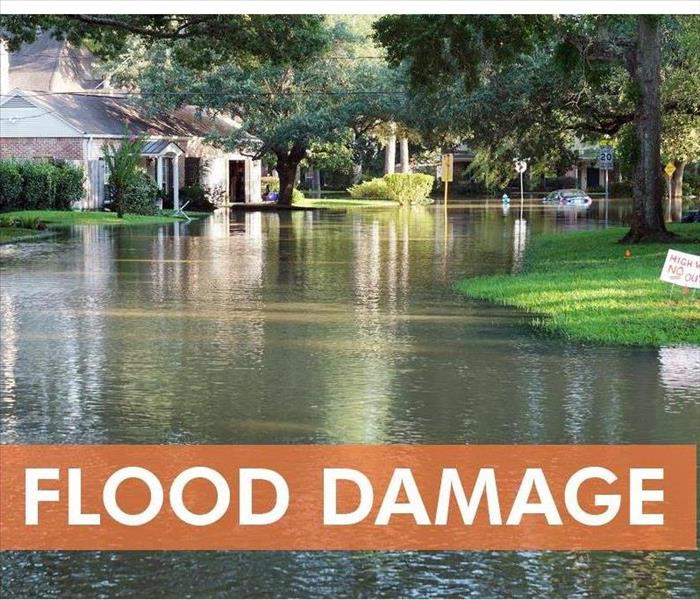 SERVPRO is committed to respond immediately to any size disaster.
SERVPRO is committed to respond immediately to any size disaster.
Four Flood Prevention And Safety Tips
Homeowners can follow these four flood prevention and safety tips to promote flood safety and keep water out of a residence in Elburn,IL. While it is helpful to flood proof a property in advance, residents should comply with evacuation orders to preserve personal safety.
1. Enhance Drainage
It may be possible to significantly reduce the flood risk of a property by hiring landscaping experts to adjust the grading or slope to ensure that water flows away from the foundation. Adding fill to a property located in a flood zone may enable a homeowner to obtain an amendment or revision on the Flood Rate Insurance Map maintained by the National Flood Insurance Program, which may reduce the cost of flood insurance coverage.
2. Invest In Reusable Flood Barriers
Owners of homes in areas that frequently flood may want to invest in sandbag alternatives for flood safety. Choose from water-filled cofferdams or self-stabilizing fence barriers. Absorbent single-use alternatives are also available.
3. Install Backup Prevention Equipment
Flooding can overwhelm a municipal main and result in sewer backups. A homeowner can hire a plumber to determine whether preventative mechanisms such as a backflow valve, standpipe or overhead sewer could be effective solutions for flood proofing a basement.
4. Anchor or Elevate Critical Components
If flooding is anticipated within days or hours, homeowners should make every effort to promote personal safety while limiting losses. Anchor or elevate critical components such as fuel tanks, generators and HVAC units. Raising indoor electrical components can also reduce electrocution risks. Relocate as many appliances as possible above the anticipated flood water level.
These safety tips can reduce the likelihood that flooding will result in extensive damage and losses at a residence. In any case, flood safety is the primary concern. If a residence suffers damage, mitigation and restoration specialists can quickly arrive on site in Elburn,IL.
3 Ways Engineers Can Prevent Flooding in Urban Areas
2/13/2019 (Permalink)
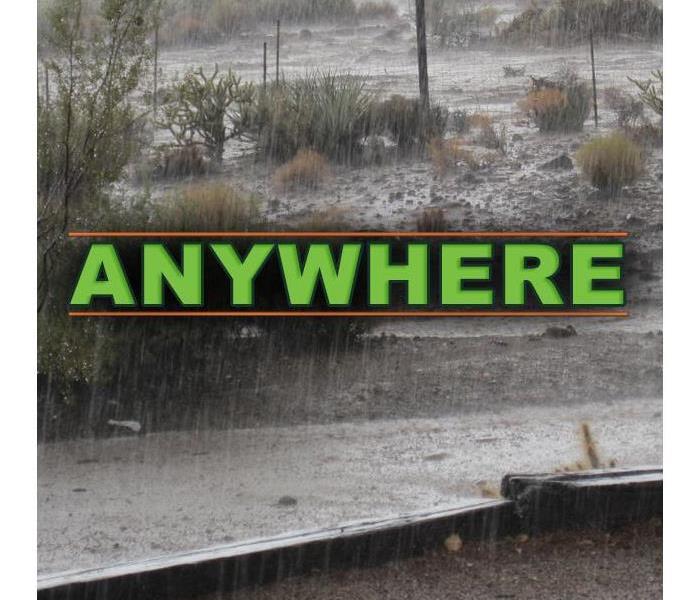 It is important that cities develop ways to stop flooding in order to protect its citizens
It is important that cities develop ways to stop flooding in order to protect its citizens
3 Ways Engineers Can Prevent Flooding In Urban Areas
Many cities throughout the world are aware of how devastating the damage caused by flooding can be. Whether they are located near large bodies of water or experience heavy rain on a consistent basis, there are several flood prevention methods engineers have used to protect the entire city. If your business in St. Charles, MO has seen its fair share of damage caused by high water and is only back in business due to the work of skilled storm damage restoration specialists, you might be wondering what tactics are actually effective at preventing floods. Here are three ways engineers have used to help prevent flooding in urban areas around the world.
1. Water Barriers
Many countries use various types of technologically advanced water barriers to stop high water in its tracks. Water gates, dams, storm surge barriers, and dikes are all methods used to keep the ocean from flooding the nearby city. Various advancements like aqua-drive motors and movable gates are increasingly efficient at stopping floods in their tracks.
2. Enhanced Drainage Systems
Since typical rigid draining systems are unable to deal with a large amount of water runoff or rainfall, one way to address urban flooding is to enhance these draining systems and make them more flexible. Some cities have even adopted sustainable drainage options by replacing impermeable surfaces like concrete with soil and plant life.
3. Constructing Flood-Proof Businesses
Cities who experience frequent high water issues and flooding have begun to rethink how they construct buildings. From constructing buildings far above flood levels to using materials that are designed to withstand contact with water for long periods of time, there are ways to help businesses and homes better withstand the damage flooding causes.
It is important that cities develop ways to stop flooding in order to protect its citizens and allow growth within the city. While there are many unique ways cities have battled flooding around the world, these three methods are a good place to start!





 24/7 Emergency Service
24/7 Emergency Service
























